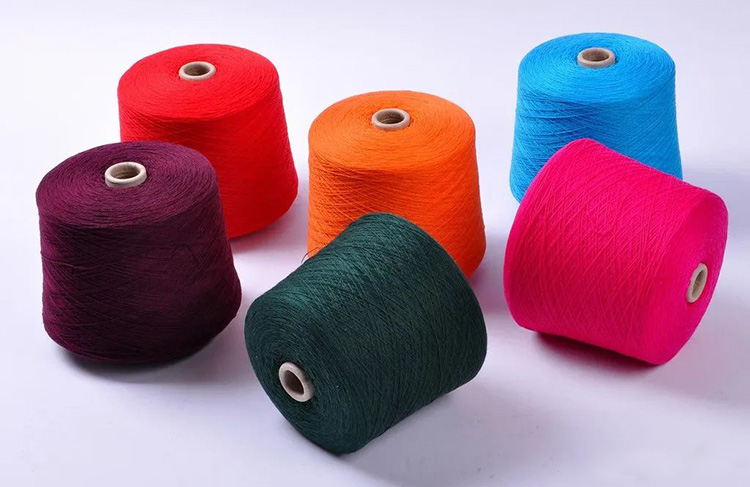Effect of Twisting Degree On Yarn Quality
2024-09-14
The twisting degree of yarn not only affects the appearance quality of yarn such as diameter and gloss, but also affects the intrinsic quality and feel of yarn such as strength, elasticity, elongation, etc. Therefore, the determination of the twisting degree of yarn is also particularly important in the textile process.
Effect on yarn diameter and density
Twisting makes the fibers in the single yarn dense, the gaps between fibers are reduced, the density of the single yarn increases, and the diameter decreases. When the twist coefficient increases to a certain value, the compressibility between fibers in the single yarn becomes very small, and the density does not change much with the increase of the twist coefficient. On the contrary, the diameter of the yarn may increase slightly due to the excessive inclination of the fibers.
The diameter and density of the ply are also related to the twist direction of the ply and the single yarn. When the twist direction of the ply is the same as that of the single yarn, the relationship between the twist coefficient and the density and diameter is similar to that of the single yarn. When the twist direction of the ply yarn is opposite to that of the single yarn, when the twist coefficient of the ply yarn is small, due to the untwisting effect of the single yarn, the density of the ply yarn will decrease and the diameter will increase; when the twist coefficient reaches a certain value, the density of the ply yarn will increase with the increase of the twist coefficient, while the diameter will decrease with the increase of the twist coefficient. With the continued twisting, the density does not change much, while the diameter gradually increases.
Impact on yarn strength
For short-fiber yarn, the most direct effect of twisting is to obtain strength, but it is not the case that the greater the degree of twisting, the greater the strength of the yarn. The reason is that twisting has both factors that are conducive to improving the strength of the yarn and factors that are not conducive to the strength of the yarn.
Favorable factors
As the twist coefficient increases, the centripetal pressure of the fiber on the yarn axis increases, the friction resistance between the fibers increases, and the possibility of the yarn breaking due to slippage between the fibers decreases.
Twisting reduces the strength unevenness of the yarn in the length direction. Under the action of tensile external force, the yarn always breaks at the point where the yarn strength is the smallest. The strength of the yarn is the external force that the weak link can withstand. As the twist coefficient increases, more twists are allocated to the weak loop, making the strength of the weak loop greater than other places, thereby increasing the strength of the yarn.
Unfavorable factors
Twisting causes the fibers in the yarn to tilt, reducing the axial force on the fibers, thereby reducing the strength of the yarn.
During the twisting process of the yarn, the fibers are prestressed. When the yarn is stressed, the ability of the fibers to bear external forces is reduced.
The effect of twisting on the strength of the yarn is the unity of opposites between the favorable and unfavorable factors mentioned above. When the twist coefficient is small, favorable factors play a leading role, which is manifested as the increase in yarn strength with the increase of twist coefficient. When the twist coefficient reaches a certain value, it is manifested as unfavorable factors playing a leading role, and the strength of the yarn decreases with the increase of twist coefficient. The twist coefficient when the yarn strength reaches the maximum value is called the critical twist coefficient (ak in the figure), and the corresponding twist is called the critical twist. In process design, a twist less than the critical twist coefficient is generally used to improve the production efficiency of the spinning machine while ensuring the strength of the spinning yarn.
Effect on yarn elongation at break
For single yarn, twisting reduces the possibility of fiber slippage in the yarn and increases fiber elongation deformation, which is manifested as a decrease in yarn elongation at break. However, as the twist factor increases, the inclination of the fiber in the yarn increases, and when stretched, there is a tendency to reduce the inclination of the fiber and thin the yarn, thereby increasing the yarn elongation at break. In general, within the generally used twist factor range, favorable factors outweigh unfavorable factors, so as the twist factor increases, the elongation at break of the single yarn increases.
For ply yarns twisted in the same direction, the effect of the twist factor on the yarn elongation at break is the same as that of single yarns. For ply yarns twisted in different directions, when the twist factor is small, the twisting of the ply yarn means the untwisting of the single yarn, and the average twist width of the ply yarn decreases with the increase of the twist factor, so the elongation at break of the ply yarn decreases slightly. When the twist factor reaches a certain value, the average twist width increases with the increase of the twist factor, and the elongation at break of the ply yarn also increases accordingly.
Effect on yarn elasticity
The elasticity of yarn depends on the elasticity of fiber and yarn structure, and the yarn structure is mainly formed by yarn twisting. For single yarn and ply yarn twisted in the same direction, twisting makes the yarn structure compact, fiber slippage is reduced, and fiber stretchability is increased. Within the general twist coefficient range, the elasticity of yarn increases with the increase of twist coefficient.
Effect on yarn gloss and feel
For single yarn and ply yarn twisted in the same direction, the yarn surface fiber tilts due to twisting, and the yarn surface becomes rough and uneven, the yarn gloss becomes worse, and the feel becomes harder. For heterogeneous twisted ply yarn, when the ratio of the ply twist coefficient to the single yarn twist coefficient is equal to 0.707, the outer layer twist width is zero, and the surface fiber is parallel to the yarn axis. At this time, the ply yarn has the best gloss and soft feel.

 English
English 한국어
한국어 বাংলা ভাষার
বাংলা ভাষার हिन्दी
हिन्दी Türkçe
Türkçe русский
русский




